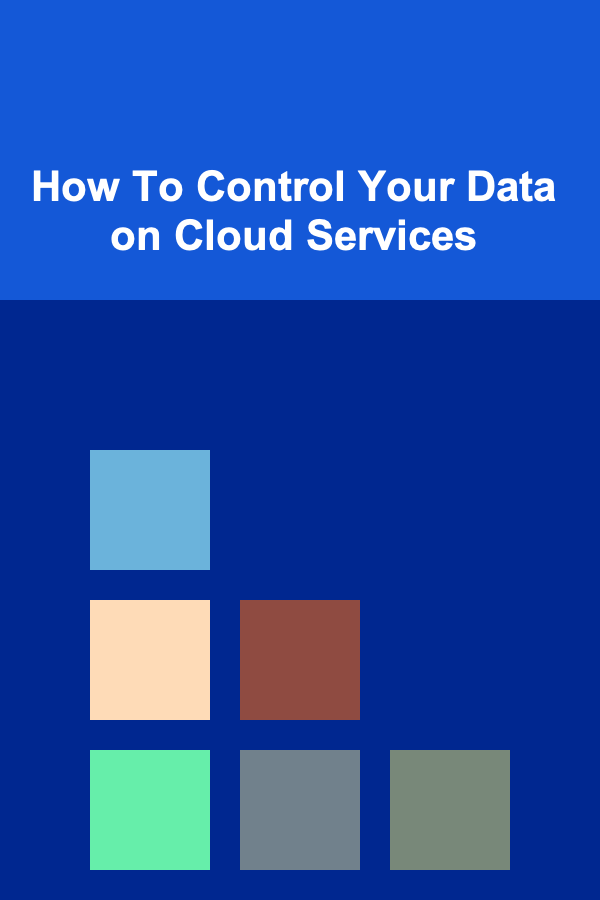
How To Control Your Data on Cloud Services
ebook include PDF & Audio bundle (Micro Guide)
$12.99$11.99
Limited Time Offer! Order within the next:

In the digital age, cloud services have become integral to personal and business operations. With cloud providers offering convenient and scalable storage, computing, and networking solutions, users can access their data anywhere at any time. However, with this convenience comes a major concern: the security and privacy of data stored on these platforms. Control over personal data is a critical issue, and understanding how to maintain it when using cloud services is essential for both individuals and organizations.
In this article, we will explore how you can control your data on cloud services. From understanding the risks to using encryption and applying security best practices, we will cover various ways to ensure that your data is safe, secure, and accessible only by you or those you authorize.
Understanding Cloud Services and Their Risks
Before we dive into how to control your data, it's essential to understand what cloud services are and the risks associated with storing your data on them. Cloud services can generally be divided into three categories:
- Infrastructure as a Service (IaaS): Provides the basic building blocks for cloud IT, such as virtual machines, storage, and networks.
- Platform as a Service (PaaS): Offers cloud platforms for developing, running, and managing applications without the complexity of building and maintaining the underlying infrastructure.
- Software as a Service (SaaS): Provides software applications hosted on the cloud and accessed through the internet (e.g., Google Drive, Dropbox, or Microsoft 365).
While cloud services offer unparalleled convenience, there are inherent risks:
- Data Breaches: Hackers may gain unauthorized access to your cloud data.
- Data Loss: Technical issues or provider errors may lead to the loss of data.
- Privacy Concerns: Cloud providers may have access to your data, raising concerns about how that data is handled.
- Vendor Lock-In: Some services make it difficult to migrate your data to another provider.
- Regulatory Compliance: You must ensure that your data complies with laws, especially when stored in foreign jurisdictions.
Understanding these risks is the first step toward implementing effective controls to protect your data in the cloud.
How to Protect Your Data in the Cloud
There are several methods and best practices to ensure that your data remains secure and under your control while using cloud services.
1. Choose a Trustworthy Cloud Provider
The first step in controlling your data is selecting a cloud provider you trust. Not all cloud services are equal when it comes to security and privacy. Some key factors to consider when choosing a provider include:
- Security Certifications: Look for cloud providers that have certifications such as ISO 27001, SOC 2, and GDPR compliance.
- Data Encryption: Ensure that the provider encrypts data both in transit and at rest.
- Data Access Controls: Providers should offer robust access controls, allowing you to specify who can access and manage your data.
- Privacy Policy: Read the provider's privacy policy carefully to understand how they handle your data.
2. Encrypt Your Data
Encryption is one of the most effective ways to control your data in the cloud. By encrypting your files, you ensure that even if hackers gain access to your data, they cannot read it without the decryption key.
Types of Encryption
There are two main types of encryption:
- End-to-End Encryption (E2EE): This type of encryption ensures that only you and those you authorize can decrypt the data. Even the cloud provider cannot access your data, as they do not have the decryption key.
- Server-Side Encryption: The cloud provider encrypts the data on their servers, but they hold the encryption key, meaning they could potentially access your data if needed.
For maximum security, opt for end-to-end encryption. Many cloud storage services, such as Tresorit and Sync.com, offer this feature, allowing you to encrypt your data before it is uploaded to the cloud.
3. Enable Multi-Factor Authentication (MFA)
Passwords alone are no longer sufficient to protect your cloud accounts. Multi-factor authentication (MFA) adds an additional layer of security by requiring you to verify your identity through more than one method.
MFA typically involves two or more of the following factors:
- Something you know: A password or PIN.
- Something you have: A smartphone app that generates time-based codes (e.g., Google Authenticator or Authy).
- Something you are: Biometric factors such as fingerprint or facial recognition.
By enabling MFA, even if an attacker gains access to your password, they will still need the second factor to access your account, significantly reducing the chances of unauthorized access.
4. Use Strong Passwords and Password Managers
A strong password is one of the most basic yet important steps in securing your cloud data. A strong password should be long, unique, and contain a mix of characters (letters, numbers, and symbols). Avoid using easily guessable information, such as your name, birthday, or common words.
For added convenience and security, use a password manager to generate and store your passwords. Password managers can create complex, random passwords for each of your cloud accounts and securely store them, so you don't need to remember them.
5. Manage Access Control
One of the most significant advantages of cloud services is the ability to share data. However, sharing comes with risks if access is not properly managed. Cloud providers typically allow you to set permissions for who can access your data.
When managing access control, consider the following:
- Least Privilege Principle: Grant users the minimum level of access necessary for their tasks. This reduces the risk of accidental or intentional misuse of your data.
- Role-Based Access Control (RBAC): If you're managing a team, use RBAC to assign permissions based on roles rather than individuals.
- Audit Logs: Regularly review the access logs to monitor who has accessed your data and what actions they have taken.
By managing access control effectively, you ensure that only authorized individuals can view or modify your data.
6. Backup Your Data Regularly
Despite all the security measures, cloud services can experience technical failures or data loss due to unforeseen issues. To avoid losing important data, make sure you back up your cloud data regularly.
Some strategies for backing up cloud data include:
- Local Backups: Keep a copy of your critical data on an external hard drive or another secure storage device.
- Redundant Cloud Backups: Use a second cloud provider or service to back up your most important data, so you have a fail-safe in case one provider experiences issues.
By maintaining backups, you ensure that your data is not permanently lost if something goes wrong with your cloud service.
7. Understand Data Sovereignty
Data sovereignty refers to the legal jurisdiction where your data is stored and processed. Depending on the country or region, there may be different laws governing how your data is handled, stored, and accessed.
For example, the General Data Protection Regulation (GDPR) in the European Union offers strong privacy protections, while other countries may have more lenient laws. Before storing sensitive data on a cloud service, you should:
- Research the provider's data centers: Find out where the provider's data centers are located and what regulations apply in those regions.
- Understand the provider's data-sharing practices: Ensure the provider does not share your data with third parties unless required by law.
Knowing where your data resides and which laws govern it is crucial in maintaining control over your data.
8. Monitor and Audit Your Cloud Accounts
Regular monitoring and auditing of your cloud accounts are essential for ensuring ongoing control over your data. Most cloud providers offer tools that allow you to track activity and changes within your account.
Key monitoring actions include:
- Reviewing login activity: Check for suspicious logins or login attempts from unusual locations or devices.
- Auditing file access: Review who has accessed your files and whether they made changes.
- Configuring alerts: Set up alerts to notify you when sensitive data is accessed or when any unusual activity occurs.
By staying vigilant and auditing your cloud accounts, you can quickly detect and respond to potential threats.
9. Encrypt Communication with Cloud Services
When communicating with cloud services, ensure that the communication channels are encrypted to prevent eavesdropping. Look for services that use Transport Layer Security (TLS) to encrypt data in transit.
Whether you're uploading files to the cloud or accessing them, ensuring that your communication is encrypted is a critical step in maintaining the privacy of your data.
10. Stay Informed About Security Threats
Cloud security is an ever-evolving field, and new vulnerabilities are constantly being discovered. To stay ahead of potential threats:
- Follow security blogs and news: Stay updated on the latest security breaches, vulnerabilities, and threats in cloud computing.
- Participate in security communities: Engage with other professionals and users in cloud security forums to share information and learn from others' experiences.
- Review provider security updates: Cloud providers often release security patches to address vulnerabilities. Keep track of these updates to ensure that your data remains secure.
By staying informed, you can react quickly to new threats and ensure your data remains protected.
Conclusion
Controlling your data on cloud services requires a multifaceted approach that includes selecting the right provider, using encryption, managing access, enabling strong security measures, and staying informed. While cloud services offer immense convenience, they also pose risks to the security and privacy of your data. By following best practices and implementing appropriate controls, you can mitigate these risks and ensure that your data remains under your control. Whether you are an individual user or a business, taking these steps is crucial in navigating the cloud securely and effectively.

How to Invest in Bonds and Fixed-Income Securities
Read More
How to Make Money Online as a Scriptwriter: 10 Actionable Ideas
Read More
How to Reduce Your Debt with a Strategic Plan
Read More
How To Learn New Programming Languages Quickly
Read More
Exploring CRISPR Diagnostics for Infectious Diseases
Read More
10 Tips for a Creative Yearly Planner Layout
Read MoreOther Products

How to Invest in Bonds and Fixed-Income Securities
Read More
How to Make Money Online as a Scriptwriter: 10 Actionable Ideas
Read More
How to Reduce Your Debt with a Strategic Plan
Read More
How To Learn New Programming Languages Quickly
Read More
Exploring CRISPR Diagnostics for Infectious Diseases
Read More